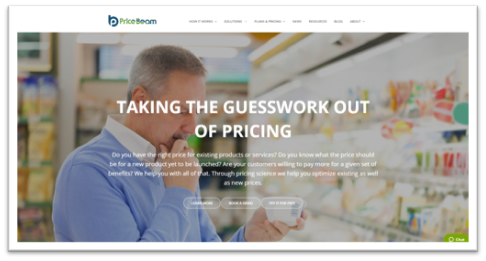Customer Value Proposition: How to Dazzle Potential Buyers
 PriceBeam
·
2 minute read
PriceBeam
·
2 minute read

Your product is awesome, and you know it. Features X, Y, and Z make your customers’ lives so much easier that they should be naming their new-born child after you. So why don’t they?
Chances are your customers don’t see what you see. Unlike you, they haven’t spent countless hours with your product and therefore, they don’t know all the benefits they get from buying it - unless you tell them!
Enter, the customer value proposition (CVP). Let’s start with defining the term, shall we?
“The customer value proposition is a statement that comprises all the benefits your customer will receive in return for his or her payment.”
That’s the definition, anyway. In reality, you don’t want it to comprise all benefits, but only those that drive significant value for your customer. Which leads us to the first point on the list.
Be Specific: Not Everybody Loves You for Everything
If you read our previous articles about customer segmentation, you know how important it is to be specific in your segmentation. You can’t market your product to everybody. And you can’t state every single benefit that comes with your product. Imagine if Oral-B were to state all the ways you can use their electrical toothbrush for cleaning purposes; it would be a waste of marketing budget as not many people would be willing to pay $50 for a cleaning brush.
Narrow your target group and focus on the benefits that drive the most value for this group. In other words, you need to identify your customer’s value drivers. Value drivers describe your customer's main priorities and so, what parameters she evaluates before deciding which product to buy and how much to pay for it. Understanding your customer’s value drivers will also allow you to target your product development at the features that truly count, send the right message with your marketing, and increase willingness-to-pay and profit.
Consistency is Key
Your customer value proposition needs to be reflected across your entire business. If you haven’t done this, you might want to take a step back and re-evaluate your brand positioning before continuing any further. If you claim you’re selling the best pencil sharpener on the market with state-of-the-art pencil sharpening technology, which guarantees perfectly sharpened pencils every time, it needs to be at least somewhat true: that is, your product and brand need to live up to this promise.
Furthermore, your price needs to seem plausible. If it’s too low, nobody is going to believe your promise and you will, moreover, lose out on substantial profit. Aligning your price positioning is crucial, but often neglected due to the widespread misconception that customers will always love you for lowering your prices, no matter what.
Cash In on Standing Out
Avoid making your product seem like a “me-too” product when writing up your customer value proposition. Focus on things that make your product unique: while your statement should comprise the main benefits of using your product, it should also point out the value customers get from using your product. You see what I did there?
Tell your customers why they get more value from purchasing your product instead of your competitors’ - how does your product provide value that can’t be found anywhere else?
Finally: Writing Your CVP
You need to make it compelling, especially if your company’s brand is not well-known. Make it convincing by using simple words and easy-to-read sentence structures: this is not the place to show off your fancy vocabulary - show off your product instead.
Using humor and writing playfully can be great ways to grab the reader’s attention, too. Of course, if you’re in the funeral service industry this might be inappropriate, but it can work for most businesses. If you’re selling boring products, this is a great way to make yourself stand out and seem less formal than the competition, which many customers will appreciate.
Once your customers know just how much value they get from buying your product, you can charge a higher price and increase profits. Learn how you set a price that is aligned with customer value perception here.



